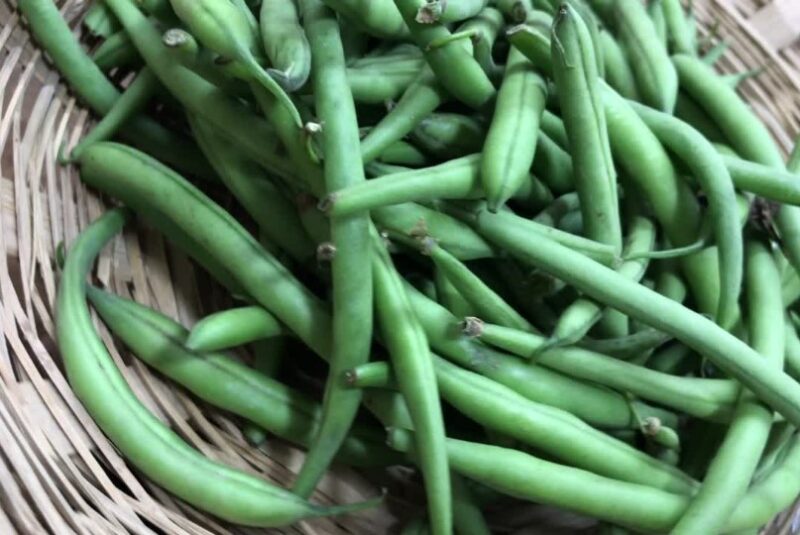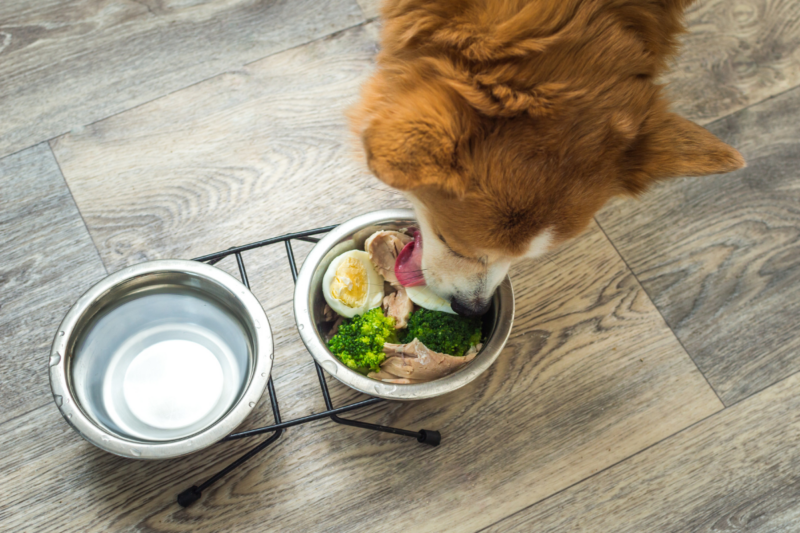Curiosity about what our furry friends can and can’t eat is only natural, especially when it comes to those adorable doggy eyes begging for a bite. So, you might be wondering, can dogs eat green beans? Well, we’re here to offer you some caring insights into this question.
Just like how we want the best for our pets, we also want to ensure they’re treated with love and the right nutrition. Let’s explore whether these crunchy green goodies are a safe and delightful treat for your canine companion.”
Why Green Beens?

Green beans are a nutritional powerhouse. They boast essential vitamins such as Vitamin C, which aids in tissue repair, Vitamin K, crucial for blood clotting, and folic acid, vital for DNA synthesis. On the mineral front, they offer iron for oxygen transport, calcium for bone health, and magnesium, which plays a role in over 300 enzymatic reactions.
Their low-calorie count combined with a hearty dose of dietary fiber makes them a top choice for health-conscious individuals.
| Nutrient | Amount (per 100g) |
|---|---|
| Calories | 31 kcal |
| Carbohydrates | 7.1 g |
| Dietary Fiber | 2.7 g |
| Sugars | 1.8 g |
| Protein | 1.8 g |
| Fat | 0.2 g |
| Vitamin A | 690 IU |
| Vitamin C | 12.2 mg |
| Vitamin K | 14.4 µg |
| Folate | 33 µg |
| Potassium | 209 mg |
| Calcium | 37 mg |
| Iron | 1.03 mg |
| Magnesium | 25 mg |
| Phosphorus | 38 mg |
| Zinc | 0.24 mg |
Are They Safe for Your Pet?

The good news for dog owners is that green beans are not only safe but can be a beneficial addition to a dog’s diet when given in moderation.
Benefits
Green beans are a boon for dogs, especially those on the heavier side. Their low-calorie content makes them an excellent treat alternative. The fiber content can aid in digestion, ensuring smooth bowel movements. Furthermore, the vitamins and minerals present can bolster a dog’s overall health, from strengthening bones to enhancing its immune response.
Potential Risks
While this vegetable is generally safe, it’s crucial to be cautious. Always ensure they are free from added salts, spices, or seasonings, as certain additives can be harmful or even toxic to dogs. Moreover, the size and shape of green beans pose a choking hazard, especially for smaller breeds, so always monitor your dog while they snack.
| Potential Risks | Explanation and Prevention |
|---|---|
| Digestive Upset | Introducing a new food can upset a dog’s stomach. Introduce green beans gradually to minimize digestive issues. |
| Gas and Bloating | High-fiber content can lead to increased gas. Monitor your dog’s response and adjust the amount as needed. |
| Allergic Reactions | Allergies to green beans are rare but possible. Watch for allergic symptoms and stop feeding if any appear. |
| Choking or Obstruction | Dogs may choke or experience intestinal obstruction if they swallow large pieces. Cut green beans into small sizes. |
| Nutrient Imbalance | Feeding excessive green beans might disrupt nutrient balance. Consult your vet to ensure a well-rounded diet. |
| Veterinary Diet Interference | Adding green beans might conflict with prescribed diets. Consult your vet if your dog has specific dietary needs. |
| Underlying Health Conditions | Certain health issues may make green beans unsuitable. Consult your vet if your dog has preexisting health conditions. |
| Canned or Salted Green Beans | Canned green beans often contain added salt. Choose fresh or plain cooked green beans to avoid excess sodium. |
Serving Green Beans to Dogs

Before tossing a handful of green beans to your dog, consider the best ways to introduce this new treat.
Preparation Methods
Offering green beans in their simplest form is best. Steamed or boiled green beans without any additives are the safest bet. Canned green beans often come with added salt, which isn’t ideal for dogs. If you’re leaning towards raw green beans, ensure they’re thoroughly washed to remove any pesticides or contaminants.
Portion Size
As with any treat, moderation is key. Start with a small quantity to gauge your dog’s reaction. For smaller breeds, consider chopping the beans to make them more manageable and reduce choking risks. Remember, treats, even healthy ones like green beans, should be an occasional delight and not a regular meal replacement. The amount depends on your dog’s size and dietary needs.
| Dog Size | Approximate Amount of Green Beans |
|---|---|
| Small (up to 20 lbs) | A few slices (about 10-20 beans) |
| Medium (20 – 50 lbs) | Half a cup to one cup |
| Large (50 – 90 lbs) | One to two cups |
| Extra Large (90+ lbs) | Two cups or more |
Green Beans as a Weight Management Tool
For those pooches carrying some extra weight, this vegetable can be a game-changer.
Low-Calorie Treat Alternative
High-calorie treats can be a significant contributor to weight gain. Green beans, with their low-calorie profile, can replace those fatty treats. They offer the satisfaction of a crunchy snack without the calorie overload, aiding in weight management.
Filling and Nutritious
When trying to manage a dog’s weight, it’s essential they still feel satiated. Mixing green beans into their regular food can increase meal volume without a significant calorie bump. This ensures they feel full while still on a calorie-restricted regimen.
What Experts Say?
The world of canine nutrition is vast, and experts have shared their thoughts on the green bean debate.
Vet Recommendations
Veterinarians, with their hands-on experience, largely agree on the benefits of these vegetables for dogs. They often recommend them as a healthier treat alternative, especially for puppies battling obesity. However, it’s always wise to have a chat with your local vet before introducing any new food into your dog’s diet.
Canine nutritionists, with their deep understanding of dog dietary needs, emphasize the rich nutrient profile of green beans. They also stress the importance of serving them in their purest form, free from potentially harmful additives. Portion control, according to them, is crucial to ensure the benefits outweigh any potential risks.
Alternatives to Green Beans

Not all dogs will take to green beans, and that’s okay. There are plenty of other healthy treat options out there.
Carrots
Carrots are another crunchy, low-calorie treat option. Rich in beta-carotene, they’re not only nutritious but also beneficial for dental health, as the crunch can help clean a dog’s teeth.
Sweet Potatoes
Cooked and mashed or cut into small pieces, sweet potatoes are rich in dietary fiber, vitamins, and minerals. They can be a great treat or supplement to your pet’s diet.
Pumpkin
Plain canned pumpkin (not pumpkin pie mix) is a favorite among many dogs. It’s rich in fiber and can help with digestive issues.
Peas
Like green beans, peas are a green vegetable that many dogs find tasty. They’re a good source of vitamins and minerals.
Broccoli

In small amounts, broccoli can be a nutritious treat. However, it should be given in moderation as large quantities can cause digestive upset.
Cucumbers
These are low-calorie and hydrating snacks that many dogs enjoy. They’re especially good for overweight pets.
Zucchini
Another low-calorie vegetable, zucchini can be given raw or cooked and is often well-tolerated by dogs.
Beets
Beets are especially good for your dog, as you can serve them both cooked and raw. Also, organic beets are perhaps the best possible choice.
FAQs:
Are frozen green beans safe for consumption?
Yes, these are a convenient option. Thaw them before giving them to your dog, as the cold temperature might be a bit shocking for their system.
Can I give my dog green bean chips or crisps?
It’s best to avoid giving your pet processed snacks, as they might contain added salt or seasonings that are harmful to them.
Is it safe to include other types of beans in my pet’s diet?
Green beans are generally safe, but other types of beans might contain toxins or be harder for dogs to digest. Stick to green beans.
Can I feed my dog raw green beans?
Yes, you can, but it’s recommended to lightly cook or blanch them to make them easier to digest.
Are these vegetables helpful with constipation?
The fiber content in it might aid in promoting regular bowel movements, but if your pet has persistent constipation, consult a vet.
Conclusion
In the vast world of canine nutrition, green beans emerge as a clear winner. They offer a blend of taste and nutrition that can benefit dogs in various ways. Whether you’re using them as a treat, a dietary supplement, or a weight management tool, the key is to serve them in their purest form and in moderation.
Always keep an eye on your dog to ensure they’re enjoying their new treat without any adverse reactions. Every dog is unique, so always be attentive to their needs and preferences. Here’s to many happy, healthy snacking moments with your furry friend!
